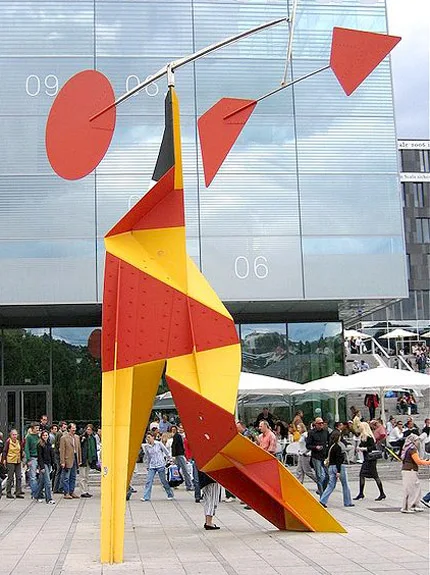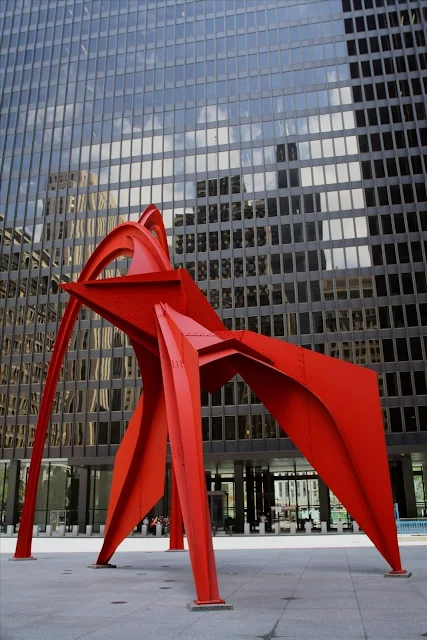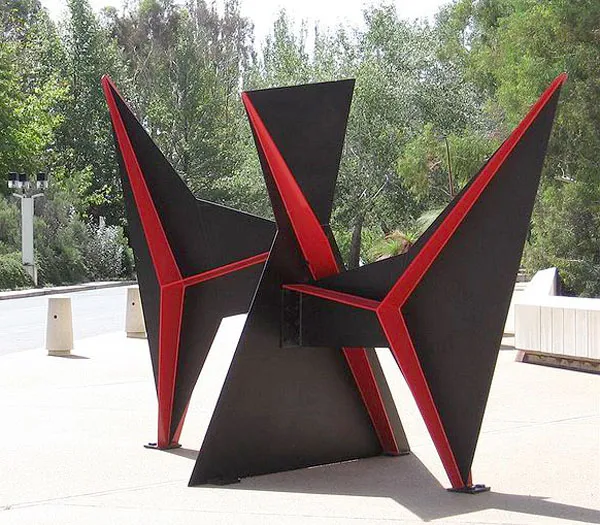Calder moved to New York and enrolled at the Art Students' League. While a student, he worked for the National Police Gazette where, in 1925, one of his assignments was sketching the Ringling Brothers and Barnum and Bailey Circus. Calder became fascinated with the circus, a theme that would reappear in his later work.
In 1926, Calder moved to Paris where he established a studio at 22 rue Daguerre in the Montparnasse Quarter. At the suggestion of a Serbian toy merchant, he began to make toys. At the urging of fellow sculptor Jose de Creeft, he submitted them to the Salon des Humoristes. Later that fall, Calder began to create his Cirque Calder, a miniature circus fashioned from wire, string, rubber, cloth, and other found objects. Designed to fit into suitcases (it eventually grew to fill five), the circus was portable, and allowed Calder to hold performances on both sides of the Atlantic. He gave improvised shows, recreating the performance of a real circus. Soon, his "Cirque Calder"[13] (usually on view at the Whitney Museum of American Art) became popular with the Parisian avant-garde. In 1927, Calder returned to the United States. He designed several kinetic wooden push and pull toys for children, which were mass-produced by the Gould Manufacturing Company, in Oshkosh, WI. His originals, as well as playable replicas, are on display in the Berkshire Museum in Pittsfield, Massachusetts. In 1928, Calder held his first solo show at a commercial gallery at the Weyhe Gallery in New York City. In 1935, he had his first solo museum exhibition in the United States at The Renaissance Society at the University of Chicago. In 1929, Calder had his first solo show of wire sculpture in Paris at Galerie Billiet. The painter Jules Pascin, a friend of Calder's from the cafes of Montparnasse, wrote the preface. In June 1929, while traveling from Paris to New York, Calder met his future wife, Louisa James, grandniece of author Henry James and philosopher William James. They married in 1931. While in Paris, Calder met and became friends with a number of avant-garde artists, including Joan Miró, Jean Arp, and Marcel Duchamp. A visit to Piet Mondrian's studio in 1930 "shocked" him into embracing abstract art.
The Cirque Calder can be seen as the start of Calder's interest in both wire sculpture and kinetic art. He maintained a sharp eye with respect to the engineering balance of the sculptures and utilized these to develop the kinetic sculptures Duchamp would ultimately dub as "mobiles", a French pun meaning both "mobile" and "motive." He designed some of the characters in the circus to perform suspended from a thread. However, it was the mixture of his experiments to develop purely abstract sculpture following his visit with Mondrian that lead to his first truly kinetic sculptures, manipulated by means of cranks and pulleys.
By the end of 1931, he moved on to more delicate sculptures which derived their motion from the air currents in the room. From this, Calder's "mobiles" were born. At the same time, Calder was also experimenting with self-supporting, static, abstract sculptures, dubbed "stabiles" by Arp in 1932 to differentiate them from mobiles. Calder and Louisa returned to America in 1933 to settle in a farmhouse they purchased in Roxbury, Connecticut, where they raised a family (first daughter, Sandra born 1935, second daughter, Mary, in 1939). Calder continued to give Cirque Calder performances but also worked with Martha Graham, designing stage sets for her ballets and created a moving stage construction to accompany Eric Satie's Socrate in 1936.
During World War II, Calder attempted to join the Marines as a camofleur, but was rejected. Instead, he continued to sculpt, but a scarcity of metal led to him producing work in carved wood.
Calder's first retrospective was held in 1938 at George Walter Vincent Smith Gallery in Springfield, Massachusetts. In 1943, the Museum of Modern Art hosted a well-received Calder retrospective, curated by James Johnson Sweeney and Marcel Duchamp.
Calder was one of 250 sculptors who exhibited in the 3rd Sculpture International held at the Philadelphia Museum of Art in the summer of 1949. His mobile, International Mobile was the centerpiece of the exhibition.
Man, a sculpture by Alexander Calder for Expo 67, on Saint Helen's Island Parc Jean-Drapeau, Montréal, Quebec
In the 1950s, Calder increasingly concentrated his efforts on producing monumental sculptures. Notable examples are ".125" for JFK Airport in 1957, "La Spirale" for UNESCO in Paris 1958 and "Man" ("L'Homme"), commissioned for Expo 67 in Montreal. Calder's largest sculpture until that time, 20.5 meters high, was "El Sol Rojo", constructed for the 1968 Summer Olympics in Mexico City.
In 1962, he settled into his new workshop Carroi, a very futuristic design and overlooking the valley of the Lower Chevrière to Saché in Indre-et-Loire (France). He did not hesitate to offer his gouaches and small mobile to his friends in the country, he even donated to the town of a stabile trônant since 1974 in front of the church: an anti-sculpture free from gravity.
He did make the most of its stabiles and mobiles at factory Biémont Tours (France), including "the Man", all stainless steel 24 meters tall, commissioned by Canada's International Nickel (Inco) for the Exposition Universelle de Montréal in 1967. All products are made from a model made by Calder, by the research department (headed by M. Porcheron, with Alain Roy, François Lopez, Michel Juigner ...) to design to scale, then by workers qualified boilermakers for manufacturing, Calder overseeing all operations, and if necessary amending the work. All stabiles will be manufactured in carbon steel, then painted for a major part in black, except the man who will be raw stainless steel , the mobiles are made of aluminum and made of duralumin.
He made most of his monumental sculpture during this time at Etablissements Biémont in Tours, France. Calder would create a model of the work, the research department would scale it to final size, then experienced boilermakers would complete the actual metalwork — all under Calder's watchful eye. Stabiles were made in carbon steel; mobiles were mostly aluminum.
In 1966, Calder published his Autobiography with Pictures with the help of his son-in-law, Jean Davidson. In June 1969, Calder attended the dedication of his monumental stabile “La Grande Vitesse” in Grand Rapids, Michigan. This sculpture is notable for being the first public work of art in the United States to be funded with federal monies; acquired with funds granted from the then new National Endowment for the Arts under its “Art for Public Places” program.
Calder created a sculpture called WTC Stabile (also known as Bent Propeller), which in 1971 was installed at the entrance of the World Trade Center's North Tower. When Battery Park City opened, the sculpture was moved to Vesey and Church Streets.[14] It stood in front of 7 World Trade Center when it was destroyed on September 11, 2001.[15]
Calder died on November 11, 1976, shortly after opening a major retrospective show at the Whitney Museum in New York. He had been working on a third plane, entitled Salute to Mexico, when he died.
From Wikipedia




























No comments:
Post a Comment